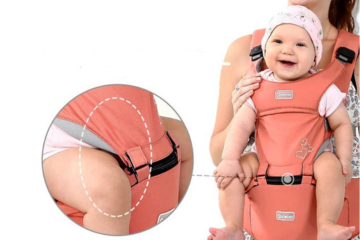
How to select the ideal baby carrier for both you and your baby?
Share

1. Understand Different Types of Baby Carriers
There are several types of baby carriers, each with its own benefits:
-
Wraps: Made from long pieces of fabric, wraps are versatile and can be tied in different ways to suit your comfort and your baby’s needs. They’re great for newborns and offer a snug fit.
-
Slings: These are one-shouldered carriers made from a single piece of fabric. Slings are quick to put on and take off, making them ideal for short trips. They work well for newborns and toddlers.
-
Soft-structured carriers: These carriers have padded straps and waistbands, providing better support for longer periods. They often have buckles and are adjustable, making them a popular choice for parents on the go.
-
Mei Tais: A hybrid between wraps and soft-structured carriers, Mei Tais have a simple design with a panel of fabric and four straps. They offer flexibility and support for both baby and parent.
-
Backpack carriers: These are designed for older babies and toddlers. They provide great support and are perfect for outdoor activities like hiking.
2. Consider Your Baby’s Age and Weight
Your baby’s age and weight are critical factors in choosing a carrier:
-
Newborns (0-3 months): Look for a carrier that provides head and neck support. Wraps, slings, and some soft-structured carriers are ideal.
-
Infants (3-12 months): As your baby gains head control, you can switch to carriers that allow multiple carrying positions, like facing in or out.
-
Toddlers (12+ months): For older babies, choose carriers that distribute weight evenly, such as soft-structured carriers or backpack carriers.
3. Evaluate Comfort for Both Baby and Parent
Comfort is key when it comes to baby carriers. Here are some features to consider:
-
Support: Ensure the carrier provides adequate support for your baby’s head, neck, and hips. For you, look for padded shoulder straps and waistbands to distribute the weight evenly.
-
Adjustability: The carrier should be adjustable to fit different body types. This is especially important if multiple caregivers will be using it.
-
Breathability: Choose a carrier made from breathable fabric, especially if you live in a warm climate or plan to use it for extended periods.
-
Ease of Use: Some carriers are easier to put on and take off than others. If you’re new to babywearing, look for a carrier with simple instructions and minimal adjustments.
4. Consider Your Lifestyle and Activities
Your daily activities and lifestyle will also influence your choice:
-
On-the-go parents: If you’re often out and about, a soft-structured carrier or a sling that’s easy to use might be your best bet.
-
Active parents: For hiking or long walks, consider a backpack carrier that provides ample support for both you and your baby.
-
At-home use: If you plan to use the carrier mainly at home, a wrap or Mei Tai might offer the comfort and flexibility you need.
5. Safety First
Safety should always be your top priority:
-
Check weight limits: Ensure the carrier is appropriate for your baby’s weight and age.
-
Proper positioning: Your baby should be in a natural, ergonomic position with their knees higher than their bottom, resembling an “M” shape.
-
Inspect the carrier: Look for sturdy stitching, secure buckles, and durable fabric to ensure your baby’s safety.

